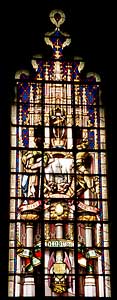 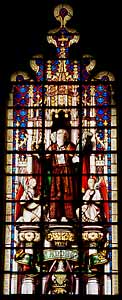 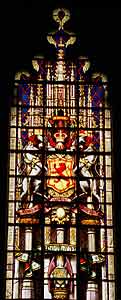 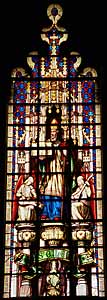
These are the four stained glass windows situated on the first
floor of the Monument in the Museum room.
They were designed by David Roberts and made by James Ballantine.
The installation was proposed by the Trustees’ Committee in
1855 and £300 found from the Special Purposes Fund, the windows
would ‘convey to distant times a favourable idea of the state
of the Art in Edinburgh in the 19th century’.
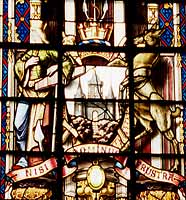
The first window shows the coat-of-arms
of the City of Edinburgh with the motto ‘NISI DOMINUS FRUSTRA’.
From early times, and certainly from the 14th century, Edinburgh
(like other royal burghs of Scotland) used armorial devices in many
ways, including on seals. In 1732, the ‘achievement’
or ‘coat of arms’ was formally granted by the Lord Lyon
King of Arms.
The shield shows a castle with three towers and an entrance with
a portcullis shown lowered. It stands upon a rock of stony colours.
(The castle has long been a symbol for Edinburgh, the Castle Rock
having been fortified since Neolithic times.)
The motto ‘NISI DOMINUS FRUSTRA’ has been associated
with Edinburgh since 1647. The interpretation is ‘Except the
Lord in Vain’ and is a normal heraldic contraction of a verse
from the 127th Psalm:
‘Except the Lord build the house, They labour in
vain that build it
Except the Lord keep the city, The watchman waketh but in vain’
Two figures or ‘supporters’ flank the shield. The
doe or hind on the right is associated with St Giles, the city’s
patron saint.
^ back to the top
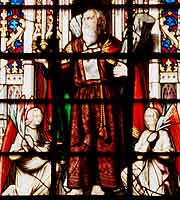
The second window shows Saint Andrew
the patron Saint of Scotland. Andrew was a fisherman from Galilee,
who went on to spread the Christian religion in Greece and Asia
Minor. He is believed to have been crucified on an X-shaped cross
known as a Saltire Cross (one of the many Medieval customs of torture)
in Patras in Southern Greece.
Some 300 years after his death, the Emperor Constantine was going
to move the saints bones, and legend has it that a greek monk called
Saint Rule, was warned of this in a dream by an angel, who told
him to remove the saints bones to the "ends of the Earth"
to keep them safe.
Scotland was as near to the ends of the Greek world as you could
get at that time, and and it was here that St. Rule was shipwrecked
with his precious cargo. The monk brought the holy relics ashore
at what is now St Andrews.
^ back to the top
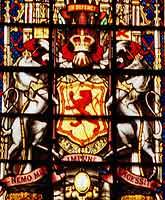
The third window shows the coat-of-arms
of Scotland, the Lion Rampant shield flanked by a pair of unicorns.
The motto of the Order of the Thistle "NEMO ME IMPUNE LACESSIT",
which means "No one injures (attacks) me with impunity",
is written on a scroll underneath.
^ back to the top
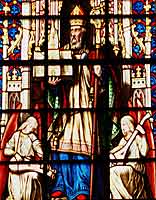
The fourth window shows Saint Giles the
patron saint of Edinburgh. Giles was a popular saint in the Middle
Ages. He was the patron saint of cripples and lepers, and his reputation
spread through France and England to Scotland, partly as a result
of the Crusades.
^ back to the top
|



